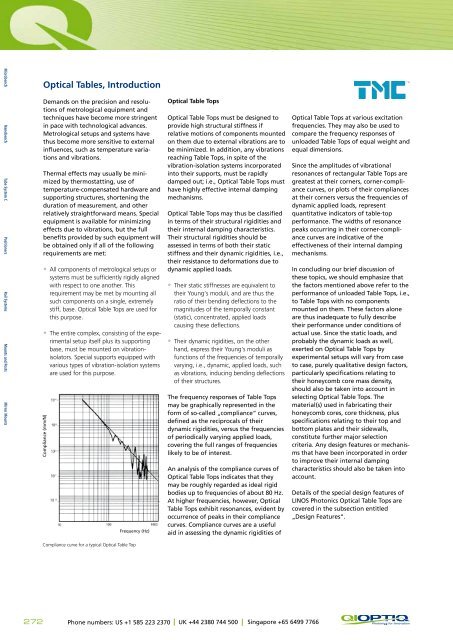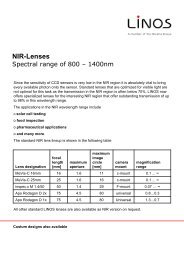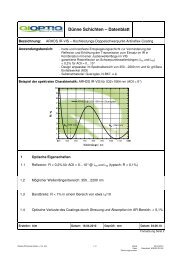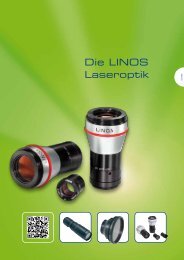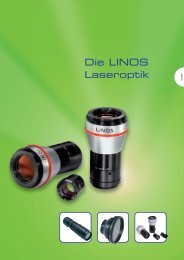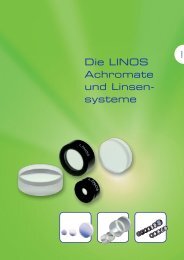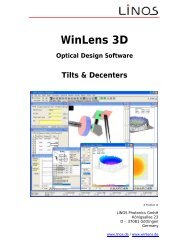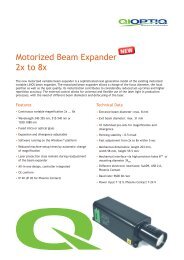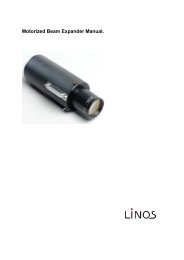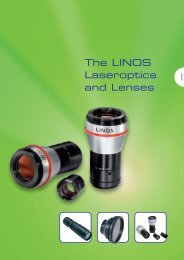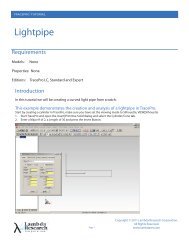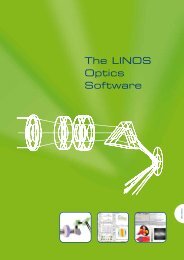08-Optical Tables.pdf - Qioptiq Q-Shop
08-Optical Tables.pdf - Qioptiq Q-Shop
08-Optical Tables.pdf - Qioptiq Q-Shop
You also want an ePaper? Increase the reach of your titles
YUMPU automatically turns print PDFs into web optimized ePapers that Google loves.
Microbench Nanobench Tube System C Positioners Rail Systems Mounts and Posts Mirror Mounts<br />
<strong>Optical</strong> <strong>Tables</strong>, Introduction<br />
Demands on the precision and resolutions<br />
of metrologi cal equipment and<br />
techniques have become more stringent<br />
in pace with technological advances.<br />
Metrological set ups and systems have<br />
thus become more sensitive to external<br />
influences, such as temperature variations<br />
and vibrations.<br />
Thermal effects may usually be minimized<br />
by thermo stat ting, use of<br />
temperature-compensated hardware and<br />
supporting structures, shortening the<br />
duration of mea sure ment, and other<br />
relatively straightforward means. Special<br />
equipment is available for minimizing<br />
effects due to vibrations, but the full<br />
benefits provided by such equipment will<br />
be obtained only if all of the following<br />
requirements are met:<br />
••<br />
All components of metrological setups or<br />
systems must be sufficiently rigidly aligned<br />
with respect to one another. This<br />
requirement may be met by mounting all<br />
such components on a single, extremely<br />
stiff, base. <strong>Optical</strong> Table Tops are used for<br />
this purpose.•<br />
••<br />
The entire complex, consisting of the experimental<br />
setup itself plus its supporting<br />
base, must be mounted on vibrationisolators.<br />
Special supports equipped with<br />
various types of vibration-isolation systems<br />
are used for this purpose.<br />
Compliance (mm/N)<br />
Frequency (Hz)<br />
<strong>Optical</strong> Table Tops<br />
<strong>Optical</strong> Table Tops must be designed to<br />
provide high structural stiffness if<br />
relative motions of components mounted<br />
on them due to external vibrations are to<br />
be minimized. In addition, any vibrations<br />
reaching Table Tops, in spite of the<br />
vibration-isolation systems incorpo rated<br />
into their supports, must be rapidly<br />
damped out; i.e., <strong>Optical</strong> Table Tops must<br />
have highly effective internal damping<br />
mechanisms.<br />
<strong>Optical</strong> Table Tops may thus be classified<br />
in terms of their structural rigidities and<br />
their internal damping cha rac teristics.<br />
Their structural rigidities should be<br />
assessed in terms of both their static<br />
stiffness and their dynamic rigidities, i.e.,<br />
their resistance to deformations due to<br />
dynamic applied loads.<br />
••<br />
Their static stiffnesses are equivalent to<br />
their Young‘s moduli, and are thus the<br />
ratio of their bending deflec•tions to the<br />
magnitudes of the temporally constant<br />
(static), concentrated, applied loads<br />
causing these deflections.•<br />
••<br />
Their dynamic rigidities, on the other<br />
hand, express their Young‘s moduli as<br />
functions of the frequencies of temporally<br />
varying, i.e., dynamic, applied loads, such<br />
as vibrations, inducing bending deflections<br />
of their structures.•<br />
The frequency responses of Table Tops<br />
may be graphi cally represented in the<br />
form of so-called „compliance“ curves,<br />
defined as the reciprocals of their<br />
dynamic rigi di ties, versus the frequencies<br />
of periodically varying applied loads,<br />
covering the full ranges of frequencies<br />
likely to be of interest.<br />
An analysis of the compliance curves of<br />
<strong>Optical</strong> Table Tops indicates that they<br />
may be roughly regarded as ideal rigid<br />
bodies up to frequencies of about 80 Hz.<br />
At higher frequencies, however, <strong>Optical</strong><br />
Table Tops exhibit resonances, evident by<br />
occurrence of peaks in their compliance<br />
curves. Compliance curves are a useful<br />
aid in assessing the dynamic rigidities of<br />
<strong>Optical</strong> Table Tops at various excitation<br />
frequencies. They may also be used to<br />
compare the frequency responses of<br />
unloaded Table Tops of equal weight and<br />
equal dimensions.<br />
Since the amplitudes of vibrational<br />
resonances of rec tang ular Table Tops are<br />
greatest at their corners, corner-compliance<br />
curves, or plots of their compliances<br />
at their corners versus the frequencies of<br />
dynamic applied loads, represent<br />
quantitative indicators of table-top<br />
per formance. The widths of resonance<br />
peaks occurring in their corner-compliance<br />
curves are indicative of the<br />
effec tiveness of their internal damping<br />
mechanisms.<br />
In concluding our brief discussion of<br />
these topics, we should emphasize that<br />
the factors mentioned above refer to the<br />
performance of unloaded Table Tops, i.e.,<br />
to Table Tops with no components<br />
mounted on them. These factors alone<br />
are thus inadequate to fully describe<br />
their performance under conditions of<br />
actual use. Since the static loads, and<br />
probably the dynamic loads as well,<br />
exerted on <strong>Optical</strong> Table Tops by<br />
experimen tal setups will vary from case<br />
to case, purely qualitative design factors,<br />
particularly specifications relating to<br />
their honeycomb core mass density,<br />
should also be taken into account in<br />
selecting <strong>Optical</strong> Table Tops. The<br />
material(s) used in fabricating their<br />
honeycomb cores, core thickness, plus<br />
specifications relating to their top and<br />
bottom plates and their sidewalls,<br />
constitute further major selection<br />
criteria. Any design features or mechanisms<br />
that have been incorporated in order<br />
to improve their internal damping<br />
characteristics should also be taken into<br />
account.<br />
Details of the special design features of<br />
LINOS Photonics <strong>Optical</strong> Table Tops are<br />
covered in the subsection entitled<br />
„Design Features“.<br />
Compliance curve for a typical <strong>Optical</strong> Table Top<br />
272 Phone numbers: US +1 585 223 2370 UK +44 2380 744 500 Singapore +65 6499 7766


